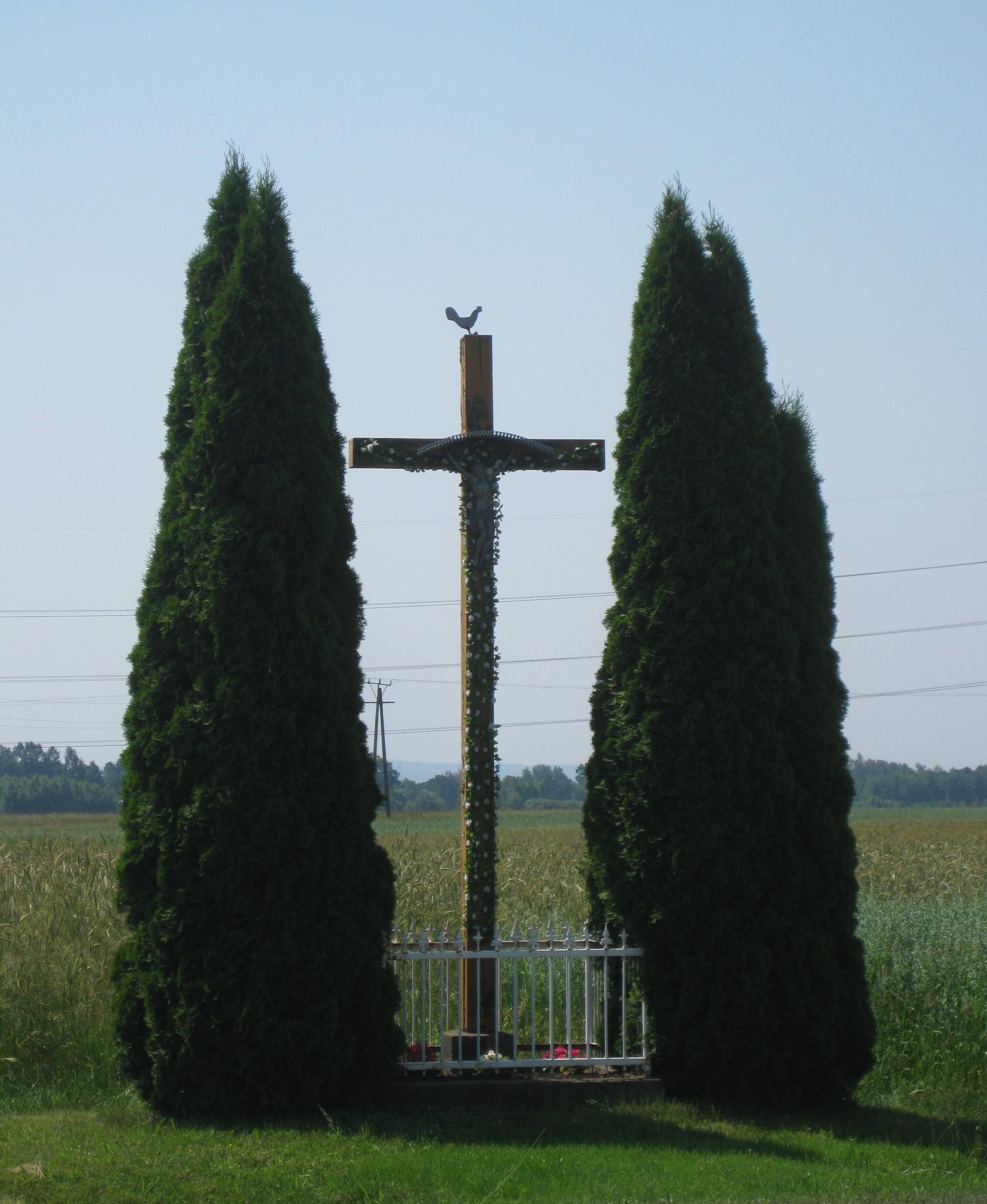
Nagoszyn,Debica, Poland
(c) 2012 barefoot photos
Continuing our tour, on Day Two, we arrived at the parish office in Nagoszyn for our appointment with the assistant pastor at 7 PM. There was a slim window when the clergy would be available to answer questions, counsel parishioners and in our case, assist research. Our work would now focus on the Moraniec – Lipa lines. We came to Poland knowing the most about Big Joe Moraniec’s family history because Cousin Jasia, a very experienced genealogist found us online through ancestry.com. She taught me how to locate and translate microfilms from the Family History (Mormons) folks. .

Nagoszyn, Debica, Poland
(c) 2012 barefoot photos
The three of us waited on benches in the hall as one by one, folks went in for a private session with the vicar, Father Damian Blinker. Finally our turn arrived. Father had the record book laid out on his desk, opened to Joseph Moraniec. We were allowed to take a photo. Unfortunately, we were not going to be able to see anything other than that. It was very disappointing. Alas, trying to see records is always a tricky proposition, whether in the US or overseas.
We set out for the Nagoszyn cemetery the next morning, hoping to find some information on Moraniecs and Lipas. Again, the graveyard was set on the outskirts of town, just a bit behind the c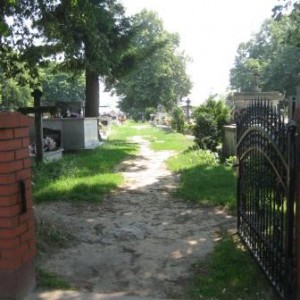 hurch. It was another very warm day, and Rebecca and I breathed a sigh of relief when we saw that it was much smaller than the Tarnowiec site. Most of the graves were too new for us to be able to connect them to our known family tree, but we did glean some information.
hurch. It was another very warm day, and Rebecca and I breathed a sigh of relief when we saw that it was much smaller than the Tarnowiec site. Most of the graves were too new for us to be able to connect them to our known family tree, but we did glean some information.
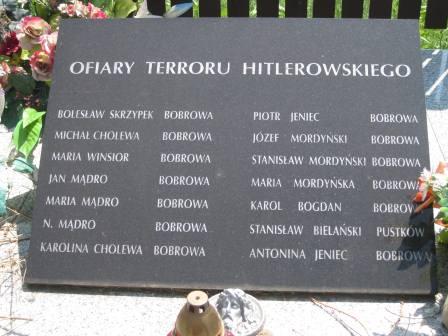
One of the most interesting bits we learned was that my greatgreat grandfather, Max Moraniec’s sis Hedwig’s son and wife, Joseph (my 1st cousin 3 times removed!) and Maria Lipa Mordynski. died in the Hitler terror of WW2. Real Polish Patriots!
Across the street from the main cemetery was the cholera cemetery. At some point, folks realized that those who died from this water borne disease should be buried separate from the other burials. I thought of how the Brontes of English Literary fame, died. Their father was a pastor of an English country church. The dead were buried on a hill right behind the church. This worked out well until there was a cholera epidemic, at which time the Brontes’ well water was contaminated from the burials. they discovered too late. Two of the greatest writers in the English language died in their twenties because of cholera.
At any rate, we didn’t see any familiar names in the cholera cemetery. Those Moraniec genes are strong.
After lunch in the car we walked over to the church. This time, it was open and we were able to go inside and take some photos. St. Anthony of Padua is not the actual church building Big Joe would have been baptized in; the wooden church burned down. This church was built in the 1920s.
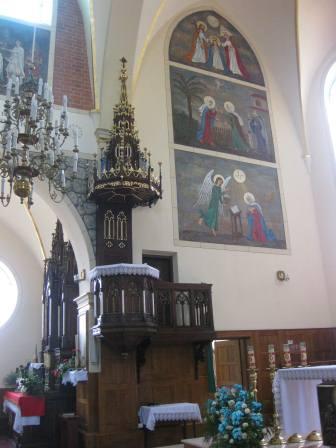
Nagoszyn, Debica, Poland
(c) 2012 barefoot photos
After we had our fill of exploring the church, we drove through Bobrowa looking for the Moraniec house #15. I snapped a few shots of the area, though the house does not seem to be there anymore. Meanwhile, Iwona dropped in on the soltis or mayor of Bobrowa. He said there were no longer any Moraniecs left in town.
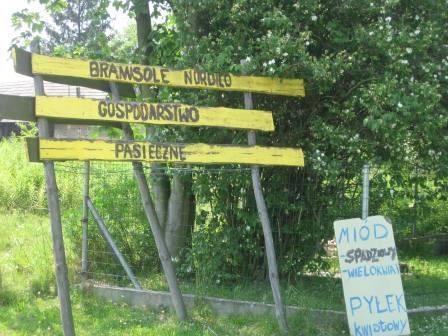
Bobrowa, Debica, Poland
(c) 2012 barefoot photos
We explored a bit more and then stopped in on the famous Bobrowa honey lady. A delightful woman, she knew Moraniecs!

Bobrowa, Debica, Poland
(c) 2012 barefoot photos
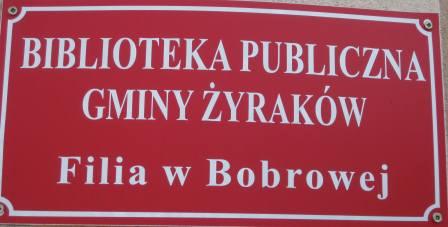
Zyrakow, Debica, Poland
(c) 2012 barefoot photos
We wanted more information about how Big Joe’s people would have lived, so we tried to find some more information at the public library. Zyrakow (next to Bobrowa) Library was open. Funny thing is, one of the librarians is writing a history of the area. Unfortunately, she does not speak English. Iwona translated for us. Who knows, Big Joe may make it into the book!
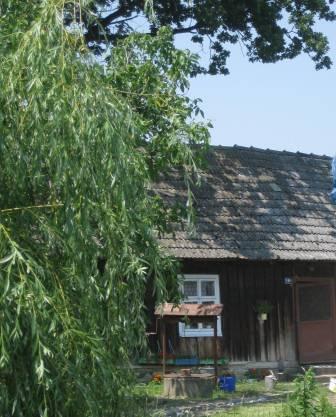
(c) 2012 barefoot photos
That was the end of our 2012 genealogical foray into Poland. An amazing adventure and trip of a lifetime. My original purpose for digging into the family history was to learn exactly where we came from. And now, as far as my mom’s side, I do. I’m sure she’s as thrilled in heaven as I am down here. 🙂
7 responses to “The Moraniec and Garbaczyk Homeland, day three”
Very nice description of your experience! My family, Kołodziej, also comes from Nagoszyn and are one of the most populous names in the church registers. So many of them that it is hard to figure out who belongs to whom. In the 1780’s there are several different Kołodziej having children from different house numbers and not all of them are related … or at least not within the time span of the church records.
Do you by any chance have information on the history of Nagoszyn? I’m particularly interested in the years 1600 – 1800.
Best regards, Mike
Hi there! Very much enjoyed reading your blog post on your journey to the Moraniec and Garbaczyk homeland. My wife Laura has ancestry in the Debica area of Poland and maybe one day we too will visit.
Her GIL family is believed to be from Bobrowa which I understand is included in the historical parish of Nagoszyn. I also saw GIL listed as a surname of interest for yourself. Wondering what you know about your GIL connection and also if you might know anything of the family of Jan GIL born 1907 in Buffalo NY, son of Jozef GIL and Zofia KITRYS of Bobrowa. Jan Gil lived in Buffalo for only a short time, as his parents and he went back to Poland, and he married in Mokre in 1930.
Thank you.
Happy Easter, Craig,
I was excited when I saw the names of Gil and Kitrys, but darnation, those particular individuals are not on my tree, at present.
Have you searched the LDS records? Our Mormon church shut down years ago, so I no longer am able to look things up. But I did do a quick look at familysearch.org where the BOBROWA records are online, and could not find anything. We must be related, though since we have common surnames AND ancestors from the same small town. Have you been dna tested? That might help figure things out.
Good luck in your hunt. Please keep us posted. And I do hope you make it to Debica one day. (We love travel pics!!!)
carolyn
Enjoyed your explorations, did a similar trip in 1975, but really too young to remember everything. Plan to make a second visit. Our Family name is JACHIMIEC from Nagoszyn and ROG from a nearby town. My family tree will soon be added to Ancestry
Thanks. Unfortunately, at this time we do not have those names in our tree. Good luck in your search and explorations.
Thanks for your interesting observations. I have recently begun to look into my family history and I have learned that my great grandparents were both born in Bobrowa. Julianna Piecuch and Marcin Osak emigrated to the US around the turn of the 20th century, settling in Derby CT. Going back farther on Julianna’s side there is a (Marianna) Wojcik and a (Maria) Lipa. And Craig — there is a Gil on at least one side, possibly two (different) Catharina Gils, though more research is needed!
It was something to see the plaque you photographed of Holocaust victims. I had just read what might be a reference to the tragic fate of the Mordynska household of Bobrowa. I read about the Nazi campaign in 1943 to “liquidate” Jewish people in Poland who had escaped deportation to ghettos and concentrations camps. There were “pacifications” in local villages to terrorize the population by killing those who had hidden or given aid to Jewish citizens or resistors. This is from a collection of essays entitled Microhistories of the Holocaust:
After the war, the deputy village head of Straszecin (Debica county), Jan Skowron, along with members of the village night guard, were accused of capturing two Dutch POWs, who had allegedly escaped from the nearby Pustków camp, and of handing them over to the Polish Police in the summer of 1943. The two men had previously been sheltered by Stanisław Wojko. The pacification of the nearby village of Bobrowa on 9 July 1943, where more than twenty inhabitants were killed and their property burned down, played a crucial role in the future course of events. One of the accused night guards stated the following:
“Sometime in the summer of 1943, already after the pacification of Bobrowa, Skowron´came to my house and told me to come with him to capture people, who were dangerous to the village—some sort of spies, who some said were Dutchmen. I said that maybe we could get by without doing this, but he replied that they were dangerous, that things could end tragically the way they did in Bobrowa. In Bobrowa, a stranger had spent the night in the home of Mordynska, and then the Germans shot several people in her home and those of others and burned down two homes.”
Thanks again for sharing your family history — which perhaps overlaps a little with mine at some point!
Oops, forgot to add: My great great grandmother Marianna WOJCIK married Ludovicus PIECUCH. His parents were Jacobus Piecuch and Maria LIPA (who must have died well before WW2). Marianna Wojciks and Maria Lipas keep multiplying when I look through the records. Perhaps if I can figure out more of the connections going back further, there might be a common ancestor there somewhere.
The history in the area during WW2 is so sobering and overwhelming, I felt a sense of relief when I saw that the local people had put up a commemorative stone.
Thanks again, Martha